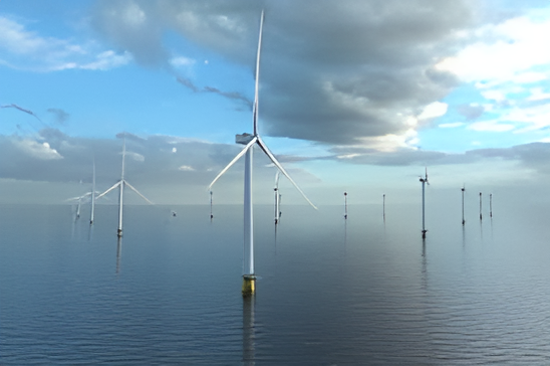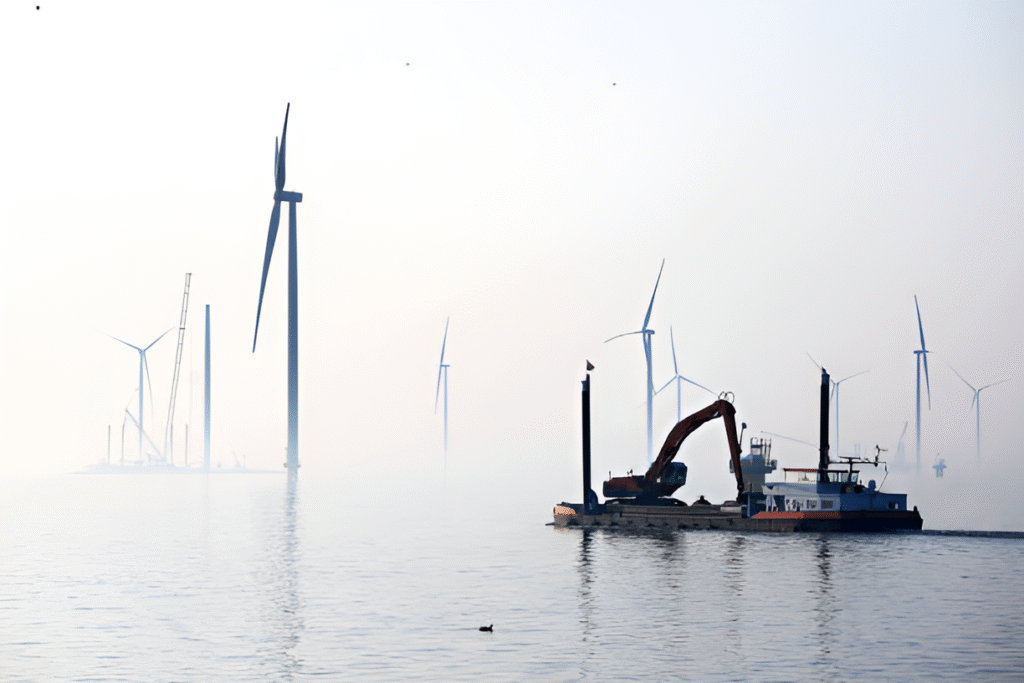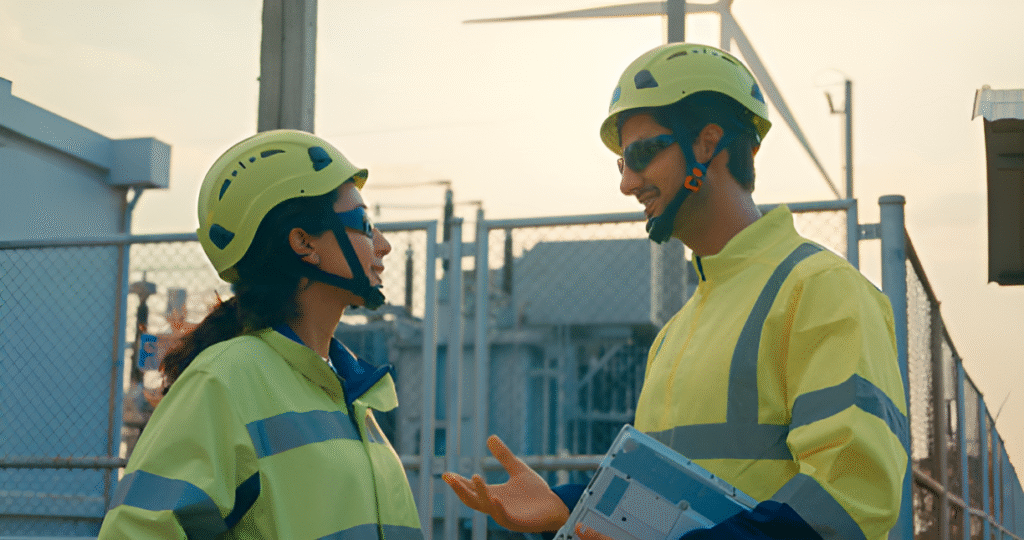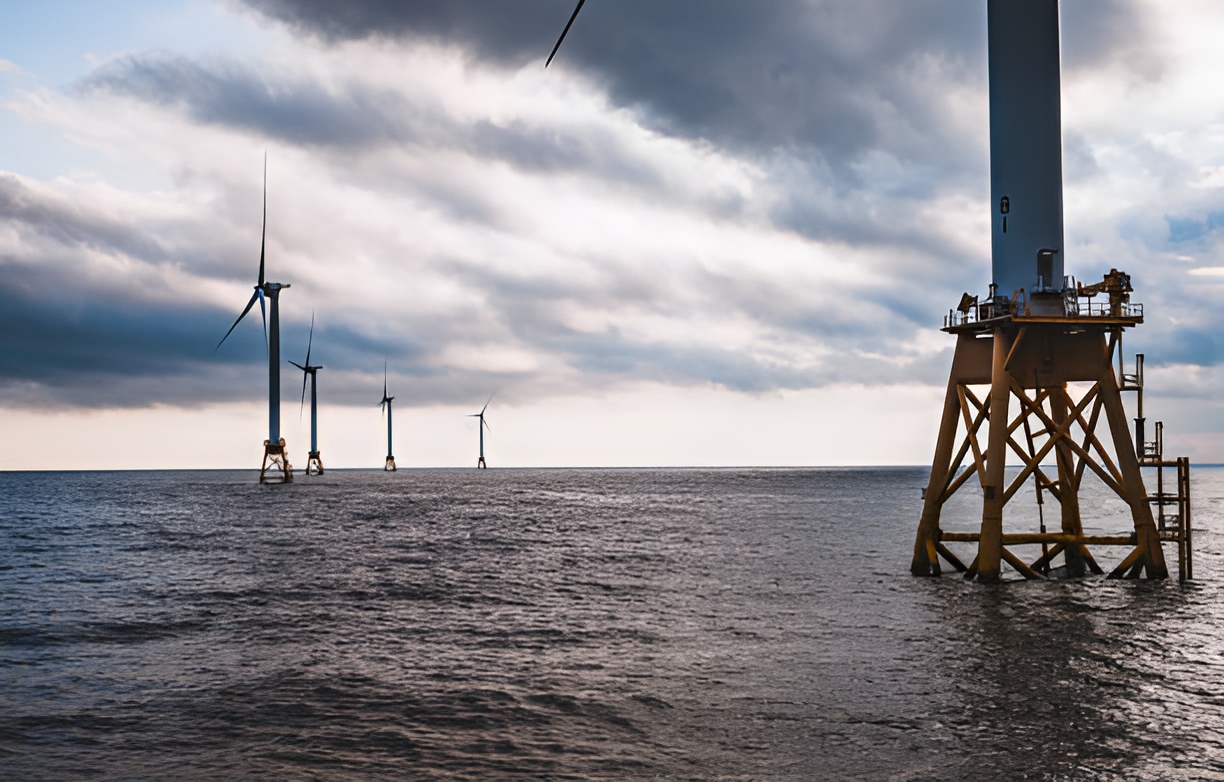Virginia Beach, VA — As the waves surge across the Atlantic and the salty wind scours the steel hulls of construction vessels, a silent revolution is emerging from the deep. The largest US offshore wind farm project, the largest one, Coastal Virginia Offshore Wind (CVOW), is springing to life some 27 miles off the coast of Virginia Beach. It’s more than a power plant. It is a symbol of the country’s clean energy future — a project that merges state-of-the-art engineering with some of the most ambitious U.S. renewable energy goals for 2030.
Dominion Energy, the leading developer of wind energy USA, is not just building a wind farm — it is writing a new chapter in U.S. clean energy transition, Covering more than 112,800 acres of federal waters, CVOW ultimately will feature 176 Siemens Gamesa turbines that will extend almost 800 feet above sea level, with rotors longer than a football field. The project will generate 2.6 GW wind project USA as renewable power when it is completed in late 2026 — enough to power more than 660,000 homes in Virginia

But the numbers are only part of the story.
On the horizon, jack-up boats sit like mechanical storks on legs, gently lowering the comically large turbine parts with the precision of a Swiss timepiece. Beneath the surface, underwater cables will run hundreds of miles, connecting clean offshore energy to onshore substations in Hampton Roads
US offshore Wind Farm Project 2025
From Pilot to Powerhouse
It began modestly in 2020, the Dominion and Ørsted started with just two 6-megawatt pilot projects — the first offshore turbines in U.S. federal waters. Those twin towers, ghostly sentinels in the middle of the Atlantic, demonstrated that the site worked, and that the technology worked.
Introducing 2024: the commercial-scale phase, with foundations spreading on the ocean floor and wind turbine parts shipping into the Port of Virginia. Workers, a considerable number of them local to the region, are erecting a future, bolt by bolt, blade by blade.
This is more than a construction site — it’s a launch pad for a national movement.
Jobs, Ports, Economy
The CVOW project isn’t just about clean energy — it represents economic revival.
Thousands of jobs are going to be created in design, construction, operations and logistics. More than 1,100 full-time jobs are expected to run the plant, and the factory already has spawned new facilities — a blade finishing plant and a staging hub at Portsmouth Marine Terminal, both for ships carrying turbine parts — in once-dormant industrial zones.

The company’s first Jones Act-compliant offshore wind turbine installation vessel, the “Charybdis,” is being constructed for CVOW. Manufactured in the U.S., it will also allow the country to cut its dependence on foreign ships — taking the country one strategic step closer to energy independence at home.
The economic impact of this US Offshore Wind Farm projects is enormous. Every visionary public infrastructure project comes with its critics—yet the development of CVOW has come responding in the Virginia wind energy sector. After a lengthy review, that included multiple stakeholder engagements where tribal nations and marine conservation groups had input, the Bureau of Ocean Energy Management (BOEM) approved of Dominion Energy.
To safeguard underwater animals, crews must adhere to rigorous mitigation measures — including acoustic monitoring for whales, low-noise pile driving and seasonal work limitations.
But the environmentalists are not letting down their guard and are calling for transparency and long-term ecological monitoring. Dominion’s task couldn’t be plainer: produce clean energy without punching an environmental hole in the Earth.
Coastal Virginia Offshore Wind Project Glimpse
Project Size: 2,600MW—enough electricity to provide for 660 000 households
Turbines: 176, 222m rotor and 14.6MW.
Area: It spans a vast 112,800 acres of federal waters
Investment: About $10.7 billion, paid by Dominion Energy
Pilot Phase: Dominion energy offshore wind and Ørsted constructed a two 6MW turbine pilot project in 2020 3.
Commercial Build-Out: Construction commenced in November 2023; offshore turbine erection began in early 2024
Allowable Milestone: BOEM approved the Commercial Construction & Operations Plan (COP) in January 2024.
ETA: Late 2026
A New American Energy Era
CVOW is not only Virginia’s victory — it’s a model for the future of US Offshore Wind Farm Project and will be the largest wind farm in North America.
With the Biden administration’s offshore wind farm target— 30 GW of offshore wind capacity by 2030—Coastal Virginia Offshore Wind Farm Projects are vital to helping the U.S. lead the world in renewables. And other projects — from New York’s Empire Wind to New Jersey’s Ocean Wind — are hanging on every detail of how the CVOW project plays out, hoping to learn from its successes and stumbles. Although President Donald Trump energy policy continues to make headlines by making strange claims about wind power
This is infrastructure but it’s also inspiration.
Project Significance
Massive Clean Power generation: At 2600 MW, CVOW will provide clean power for more than 660,000 homes and support America as it moves down America’s decarbonization pathway.
Renewable energy Job Creation and Local Economic Growth: With more than 900 construction and up to 1,100 long-term jobs, COVW is bringing large-scale green job creation to life and boosting the local economy along Virginia’s coastal economy.

Backing for Biden’s Offshore Wind Goal: The project contributes toward the national goal of generating 30GW of offshore wind capacity by 2030, putting the U.S. on a serious footing in the offshore wind energy market.
Developing Domestic Supply Chains: By agreeing to construct the first Jones Act–compliant offshore wind turbine installation vessel, Charybdis, CVOW is making way for a self-reliant U.S. offshore wind supply chain—a significant impact on the future of domestic manufacturing and the maritime industry.
Port Infrastructure and Logistics Growth: Investments in Port of Virginia and other Atlantic ports are creating permanent infrastructure to support future US offshore wind farm projects anywhere on the U.S. Atlantic seaboard. .
Future Outlook — U.S. Offshore Wind potential
The success of the Coastal Virginia Offshore Wind project represents a turning point in America’s transition to a low-carbon energy future. As a key project in the federal offshore leasing program, it serves as a model for other states and developers.
Looking ahead:
- BROADER EXPANSION OF OFFSHORE WIND: CVOW is establishing benchmarks for permitting, grid integration, and vessel logistics that will make future projects like Empire Wind Farm, is the the largest wind farm in North America and Ocean Wind more cost-effective.
- Growing U.S. Renewable Energy Infrastructure: As the transmission networks, interconnection upgrades, and renewable energy storage all progress, CVOW, together with other U.S. offshore wind objectives, helps move the nation toward a 21st century, secure grid system.
- Long-Term Climate Impact: By displacing fossil fuel–sourced electricity with offshore wind, CVOW will save millions of tons of CO ₂ annually, deepening America’s participation in international climate efforts.
- Turbine Technology First: The use of Siemens Gamesa’s 14-222 turbines at CVOW is a testament of its commitment to…employing the next-generation wind technology of wind energy in the U.S. waters.
Final Word
As turbine towers as the largest of the US offshore wind farm project emerge above the waves and energy travels ashore, Coastal Virginia Offshore Wind Project is shaping what’s achievable for clean energy in America. It is a tribute to what vision, capital and engineering can achieve when it meets the urgency of climate change.
The wind is shifting — and the future of power could be found offshore.

Hurrah! Finally I got a weblog from where I can genuinely get helpful facts regarding my
study and knowledge.
Feel free to visit my page – best rated adult sites
99d9ss
a23aya
Если нужен массовый постинг, стоит использовать спам хрумером, но важно не переусердствовать.
В разделе Автоновости Шина Про часто появляются новые обзоры и тесты. Очень удобно следить за обновлениями.
Thanks for these pointers. One thing I also believe is that credit cards providing a 0 interest often bait consumers in zero interest rate, instant acceptance and easy internet balance transfers, nonetheless beware of the most recognized factor that may void your 0 easy street annual percentage rate and also throw anybody out into the bad house rapid.
Perché Hondrolife comprare è efficace?
La sua formula con curcuma è antinfiammatoria. Le mie articolazioni sono mobili
Бонус 300% — это не шутки. Положил 1000,
получил 4000 на счёт. Отбил за вечер и ещё в плюсе.
игровой клуб Лев
Вчера зашёл, поставил 500 р на
слот с египетской темой — через
15 минут вывел 42 тысячи. Реально работает,
без обмана.
игровой клуб Лев
Друг вывел 2 млн — показал скрин, всё честно.
игровой клуб Лев
Промокод на 75 фриспинов — плюс 9к.
игровой клуб Лев
Никаких верификаций на недели — паспорт загрузил, через час одобрили.
Лев казино
Случайно зашёл в краш, поднял 7к за 5 минут
https://otrissolucoesfinanceiras.com.br/usloviya-bonusa-melbet-2025/
Бонус на день рождения 10к без депозита,
приятно
https://shaheencommunication.pk/melbet-bk-obzor-2025/
Джекпот в Mega Moolah — 12 млн, кто-то сорвал
https://8beats.techped.com.br/2025/10/19/rabochiy-promokod-melbet-2025/
Бонус на третий деп 75%, тоже взял
https://vancouvercanadahomes.com/melbet-obzor-2025
Фриспины в Starburst — 50 штук без
вейджера
https://marcosporto.eng.br/2025/10/melbet-akcii-2025-bonusy-vygody/
Бонус на выходные 50% — играю по субботам
https://kpk69.com/sayt-melbet-2025-obzor/
Вывод на Яндекс.Деньги — мгновенно
https://deltadeco.com/bk-melbet-oficialnyj-sajt-obzor-2025/
Казино не спамит смс, только важное
https://karo188.com/melbet-bonus-registraciya-2025/
Мелбет — это топ, вчера вывел
15к за 7 минут на карту Сбера, без вопросов
https://afa168.net/melbet-ru-promokod-2025/
Я знаходжу багато корисних фактів у коротких добірках, де висвітлюються podii. Це допомагає економити час.